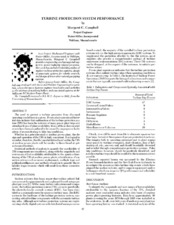| dc.contributor.other | Turbomachinery Symposium (17th : 1988) | |
| dc.creator | Campbell, Margaret C. | |
| dc.date.accessioned | 2017-10-05T14:29:04Z | |
| dc.date.available | 2017-10-05T14:29:04Z | |
| dc.date.issued | 1988 | |
| dc.identifier.uri | https://hdl.handle.net/1969.1/163607 | |
| dc.description | Lecture | en |
| dc.description | Pg. 67-76 | en |
| dc.description.abstract | The need to protect a turbine generator from abnormal operating condidtions is a given. Power plant operational historical data indicate that malfunction of the turbine protection system (TPS) has been the initiator of many power plant trips and attendant losses of plant availability. Many of these documented events have been considered to be caused by improper or faulty action of sensors leading to false trip conditions. Whether in a petrochemical or nuclear power plant, the design and operation of the TPS is fairly consistent. It is logical to consider, therefore, that the unreliabilities found within the TPS at nuclear power plants will be similar to those found at petrochemical facilities. Statistical methods of analysis to quantify the unreliability of TPS components are considered, along with the magnitude and root causes of lost availability attributable to the spurious functioning of the TPS at nuclear power plants; identification of corrective actions such as sensor replacement, multiple logic and artificial intelligence; and methods of analysis to quantify the reliability improvements which will result from these corrective actions. | en |
| dc.format.medium | Electronic | en |
| dc.format.mimetype | application/pdf | |
| dc.language.iso | en | |
| dc.publisher | Texas A&M University. Turbomachinery Laboratories | |
| dc.relation.ispartof | Proceedings of the 17th Turbomachinery Symposium | en |
| dc.subject.lcsh | Turbomachines | en |
| dc.title | Turbine Protection System Performance. | en |
| dc.type.genre | Presentation | en |
| dc.type.material | Text | en |
| dc.identifier.doi | https://doi.org/10.21423/R1HQ1J | |


